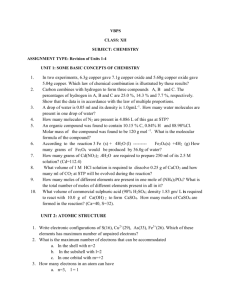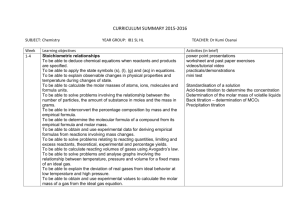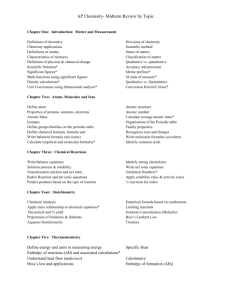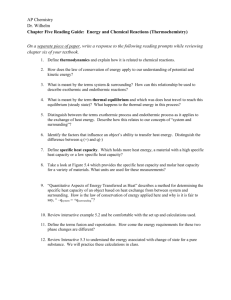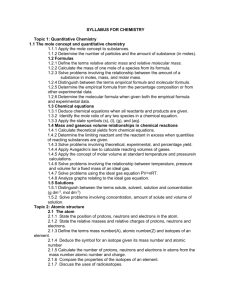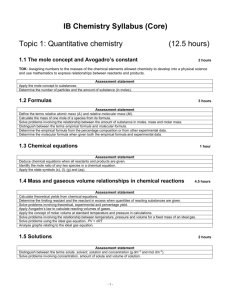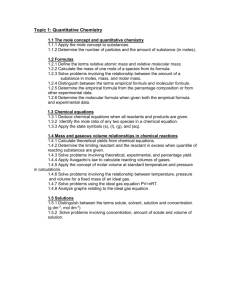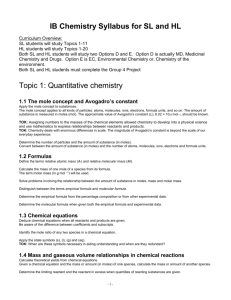CURRICULUM SUMMARY –Autumn Term (September
advertisement
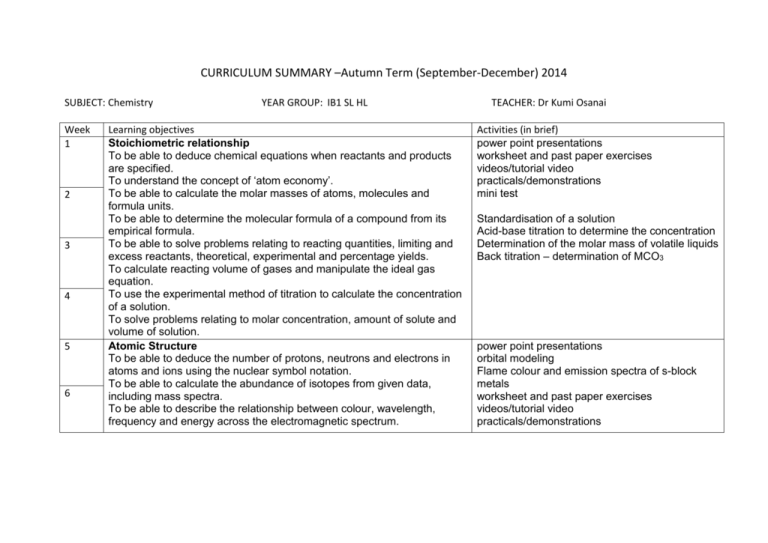
CURRICULUM SUMMARY –Autumn Term (September-December) 2014 SUBJECT: Chemistry Week 1 2 3 4 5 6 YEAR GROUP: IB1 SL HL Learning objectives Stoichiometric relationship To be able to deduce chemical equations when reactants and products are specified. To understand the concept of ‘atom economy’. To be able to calculate the molar masses of atoms, molecules and formula units. To be able to determine the molecular formula of a compound from its empirical formula. To be able to solve problems relating to reacting quantities, limiting and excess reactants, theoretical, experimental and percentage yields. To calculate reacting volume of gases and manipulate the ideal gas equation. To use the experimental method of titration to calculate the concentration of a solution. To solve problems relating to molar concentration, amount of solute and volume of solution. Atomic Structure To be able to deduce the number of protons, neutrons and electrons in atoms and ions using the nuclear symbol notation. To be able to calculate the abundance of isotopes from given data, including mass spectra. To be able to describe the relationship between colour, wavelength, frequency and energy across the electromagnetic spectrum. TEACHER: Dr Kumi Osanai Activities (in brief) power point presentations worksheet and past paper exercises videos/tutorial video practicals/demonstrations mini test Standardisation of a solution Acid-base titration to determine the concentration Determination of the molar mass of volatile liquids Back titration – determination of MCO3 power point presentations orbital modeling Flame colour and emission spectra of s-block metals worksheet and past paper exercises videos/tutorial video practicals/demonstrations 7 8 9 10 To describe the emission spectrum of hydrogen. To be able to recognize the shape of atomic orbitals of s and p. To be able to apply for the Aufbau principle, Hund’s rule and the Pauli exclusion principle to write electron configurations. (HL Additional) To be able to solve problems using E = hv. To be able to deduce the group of an element from its successive ionization energy data. To be able to explain the trends and discontinuities in first ionization energy across a period. To be able to calculate the value of the first ionization energy. Periodicity To able to deduce the electron configuration of an atom from the element’s position on the periodic table. To be able to predict the metallic and non-metallic behavior of an element. To be able to explain and describe the pH change for the reactions of Na2O, MgO, P4O10, and the oxides of nitrogen and sulfur with water. To be able to discuss the similarities and differences in the properties of elements in the same group. mini test power point presentation Properties of the alkali metals Halogen physical properties and generating chlorine Aqueous halogens/potassium halide displacement reaction Physical and chemical properties of the period 3 elements Periodic properties of the elements in the third period Shape of molecules worksheet, videos, practicals, mini test (HL Additional) To be able to explain the ability of transition metals to form variable oxidation states from successive ionization energies. To be able to explain the nature of the coordination bond within a complex (HL Additional) ion. Determining the formula of a complex ion To be able to deduce the total charge given the formula of the ion and ligands present. To be able to explain the magnetic properties in transition metals in terms of unpaired electrons. To be able to explain the effect of different ligands on the splitting of the 11 12 13 14 15 d-orbitals in transition metal complexes and colour observed using the spectrochemical series. To be able to explain the effect of the identity of the metal ion, the oxidation number of the metal and the ligand on the colour of transition metal ion complexes. Chemical bonding and structure To be able to deduce the formula and name of an ionic compound from its component ions, including polyatomic ions. To be able to explain the physical properties of ionic compounds in terms of their structure. To be able to deduce the polar nature of a covalent bond from electronegativity values. To be able to deduce the Lewis structure of molecules and ions showing all valence electron. To be able to use the VSEPR theory to predict the electron domain geometry and the molecular geometry. To be able o predict the bond angles. To be able to predict the molecular polarity from bond polarity and molecular geometry. To be able to deduce the resonance structures. To deduce the type of intermolecular force present in substances. To be able to explain the physical properties (volatility, electrical conductivity and solubility) in term of their structure and intermolecular forces. To be able to explain the electrical conductivity, malleability trend in melting points of metals. To be able to understand the properties of alloys in terms of nondirectional bonding. (HL Additional) To be able to predict whether sigma or pi bonds are formed from the linear combination of atomic orbitals. Power point presentation Shape of molecules and ions and VSEPR theory – modeling Bond polarity and intermolecular forces Intermolecular forces and ideal gas behavior Bond enthalpy and energy profile - simulation worksheet, videos, practicals, mini test 16 17 To be able to deduce the Lewis structures of molecules and ions showing all valence electrons. To be able to deduce using VSEPR theory of the electron domain geometry and molecular geometry with five and six electron domains associated with bond angles. To be able to explain the wavelength of light required to dissociate oxygen and ozone. To be able to apply FC to ascertain which Lewis structure is preferred from different Lewis structure. To be able to describe the formation of sp3, sp2 and sp hybrid orbitals in methane. To be able to identify the relationship between Lewis structure, electron domains, molecular geometries and types of hybridization. Energetics/thermochemistry To be able to calculate the heat change when the temperature of a pure substance is changes using the equation. To be able to conduct a calorimetry experiment for an enthalpy of reaction. To be able to apply the Hess’s law to calculate enthalpy changes. To be able to calculate the enthalpy. To be able to determine the enthalpy change of a reaction that is the sum of multiple reactions with known enthalpy changes. To be able to calculate the enthalpy changes from known bond enthalpy values and compare these to experimentally measured values. To be able to evaluate the potential energy profiles in exo- and endothermic reactions. To be able to understand the bond strength in ozone relative to oxygen in its importance to the atmosphere. (HL Additional) To be able to construct Born-Haber cycles to group 1 and 2 oxides and chlorides. Power point presentation Enthalpy change of displacement reaction Enthalpy change of neutralization reactions Measuring enthalpy change of a hypothetical reaction by Hess’s law worksheet, videos, practicals, mini test (HL Additional) To be able to construct the energy cycles from hydration, lattice and solution enthalpy. To be able to calculate the enthalpy changes from Born-Haber or dissolution energy cycles. To be able to relate size and charge of ions to lattice and hydration enthalpies. To be able to perform lab experiment which could include single displacement reactions in aqueous solutions.

